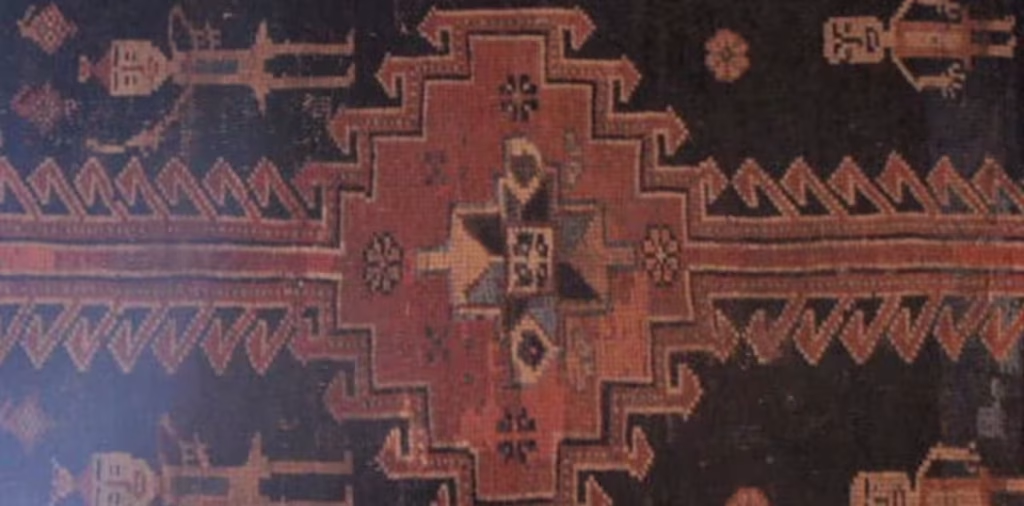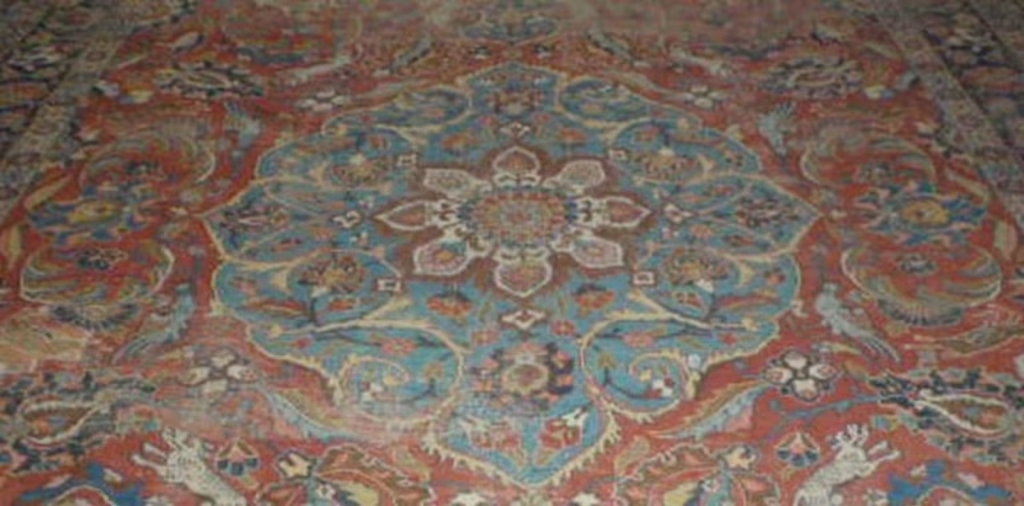Knots
There are two basic knots, the Turkish Ghiordes knot, also known as the Turk-Baft, and the Persia Sehna not, also known as the Farsi-Baft.
The difference between them is that the Ghiordes knot encircles both warp threads, while the Sehna knot encircles one but is only loosely wound round the other. The difference is clearly shown in the drawing on the next page.
Each technique has its own advantages. Ghiordes is easier to tie in a coarse carpet, while Sehna gives a more elegant surface and better definition of the pattern.
A knot tie around one warp thread was used in Spanish carpets of the 15th-17th centuries, but is not found in the East.
The deceptive Jufti or “double knot”, whereby the yarn is tied to four warp threads instead of two was first introduced in north-east Persia and parts of Turkestan. Unfortunately, this technique has spread rather rapidly. The great disadvantage is that the carpets do not wear so well, while some of the cheaper qualities lack density in the pile.
For the weaver, however, this technique doubles output as only half the numbers of knots have to be tied compared with the traditional method. The technique cuts cost but produces an inferior carpet.
To tell whether a carpet has been knotted with the Ghirodes or the Sehna knot, fold it backwards and inspect the base of the pile. The top of the Ghiordes knot can be seen going across two warp threads. The ends of the knot emerge between the two warp threads under the top of the knot to form a bushy pile. The rows of Ghiordes knots, one above the other, form a pronounced stripe. The top of the Sehna knot only covers one warp thread, so that one end of the pile emerges immediately below it and the other on the far side of the second warp thread used for the knot. The second warp thread can usually be seen by separating the ends of the pile. In most cases the type of knot can be recognized simply by feeling the pile. A carpet woven with the Ghiordes knot usually has the nap running directly towards one end, while a carpet tied with the Sehna knot will have the nap running towards one corner.
The choice of knot varies a great deal between different districts, and both types are sometimes used in one and the same locality. The main reason for this is that people from different tribes have retained their traditional technique. The Turks use the Turkish knot and the Persians the Persian, but intermarriage and migration can lead to both knots being used within the same community.
In Persia and Turkey weaving is done by men, women and children. In the Caucasus, Turkestan and among the nomads, however, only the women weave. In China, India and Pakistan it is the men who sit at the looms, while women and children do the trimming, finishing off and other details. Output naturally varies from weaver to weaver, but is approximately 6,000-12,000 knots per 8-hour shift.
The usual method of producing a carpet is as follows, a certain number of warp threads are attached to the beam, according to the width and density required in the finished carpet. A simple mechanism separates alternate warp threads into two sets, creating an alley called the shed through which the weft is passed. The position of the two sets is reversed after the passage of each weft thread.
Before starting with the carpet proper, an edge or border of varying width is first woven, sometimes with a pattern, sometimes in different coloured bands.
When this has been done, knotting can begin. With the left hand or with the hooked knife, which is held throughout in the right hand, the weaver grasps two warp threads and ties a knot round these with both hands and pulls downwards, after which the yarn is cut.
After each row of knots, weft thread is passed in between the warp threads above the row. Usually, two weft threads are passed between each row of knots. Kerman and Bijar carpets, however, have the weft in sets of three, while sets of four to six are found in carpets from Khurasan and Kazak as well as in Samarkand, Khotan, Kashgar, and Yarkand carpets of East Turkestan. These larger set produce a lateral ribbed pattern on the back of the carpet. In some cases a larger set of weft threads is included only after every fourth or sixth row of knots.
Sehna, Hamadan, Karaja and some of the Bahktiari carpets have only one weft thread between each row of knots. This technique is also discernible from the reverse of the carpet, where the warp threads are visible every other time they are left uncovered by the weft, producing a dotted appearance on the back. Another variation is to use what is known as a double warp. Here, one weft thread is passed between the warp threads at he usual tension but the next weft thread is inserted more loosely. As a result, one of the warp threads will lie behind or under the other one, and the knot will lie on its side, thus increasing the carpet’s density.
The row of knots and the wefts are now beaten together, using a heavy iron comb. This operation is repeated after every row of knots. After every third to fifth row comes the first rough trimming of the carpet, but the final trimming is not done until the carpet has been taken down from the loom. The work continues in this way until the carpet proper is finished, whereupon a second edge is woven, similar to that made at the beginning.
The sides or selvages of a carpet always have a protective edging, either woven in with the ordinary weft or over sewn after the process of weaving. The nomads ornament the sides of their carpets with tassels, and the ends are often in different colours.
Most carpets have fringes at both ends, but many from western Persia have a fringe at only one end, the other being simply the woven edge where knotting began . a fringe may be knotted or simply hang straight from the woven edge. Note that the end sewing, fringes and woven edges of carpets are frequently distinctive to certain districts, and so are of value in classification.


